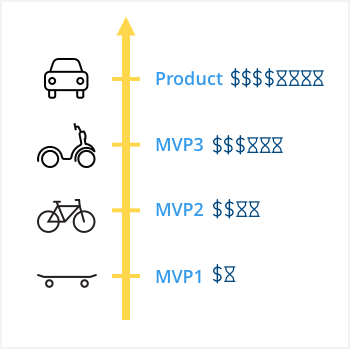Experimental development
At the heart of CRIM’s activity are experimental development projects carried out on behalf of all types of organizations and in all sectors of activity. These projects address a specific problem and are adapted to the needs and resources of each client to offer concrete deliverables. They allow organizations to succeed in their digital transition, market their expertise, and support the start-up of innovative projects by developing new groundbreaking technologies.
Experimental development consists of work carried out systematically, based on existing knowledge obtained through research and practical experience, to manufacture new materials, products or devices, establish new processes, systems and services, or substantially improve existing ones.
Concretely, experimental development can result in the following deliverables: proof of feasibility, proof of concept (POC), minimum viable product (MVP) or even prototype creation.
How do you get from an idea to a project?
Innovation is a vector of economic growth and of the prosperity of nations. This statement is so true that all major economic organizations in Canada and worldwide invest in and promote research and development initiatives.
Among the three main components of research and development, a distinction is made between fundamental research, applied research and experimental development. CRIM focuses its efforts on the second and third components.
Objectives and benefits of a proof of concept
Proof of concept, or POC, refers to the initial validation stage of a project. It consists of a demonstration, using data and tangible elements, of a project’s applicability, feasibility and viability.
Objectives
Test the proposed solution(s)
Identify the most obvious risks
Provide concrete proof of feasibility
Help assess a budget
Help frame a project
Advantages
Reduces risks
Facilitates adoption
Identifies prerequisites
Reduces costs
Limits uncertainties
What is a minimum viable product?
A Minimum Viable Product (MVP) is a version of a product that combines only its basic functionalities when it is launched on the market. The objective is to save effort on the offer’s design while learning as much as possible about the needs of potential buyers.
Customers are selected to test the unfinished version of the offer and provide feedback that helps refine the concept and develop a completed final offer later, following a series of iterations. In a sense, it is an alpha version of a product or service that will be improved over time through study and customer feedback.


Differences between proof of concept, prototype and minimum viable product
Proof of Concept
- Demonstrate feasibility
- Days or weeks of work
- Developpers or researchers
- Test an original idea
Prototype
- Show how to build the product
- Weeks
- Developers, stakeholders, users (limited)
- Obtaining financing with a general vision of the product
Minimum viable product
- Use comments or feedback to change the product
- One or several months
- Users
- Test market responsiveness and adjust the product according to user feedback












